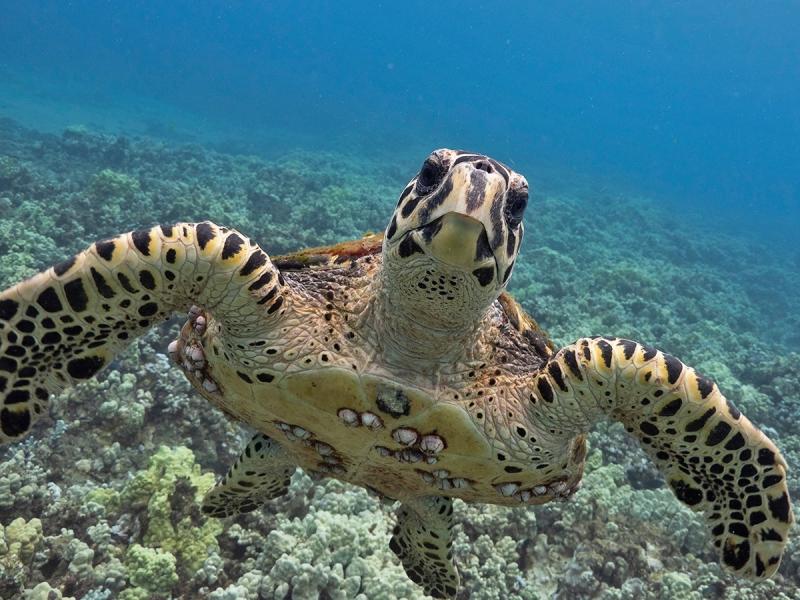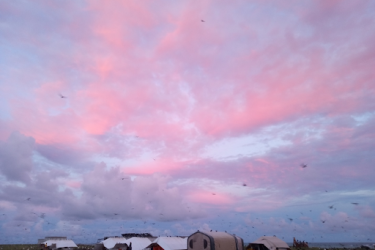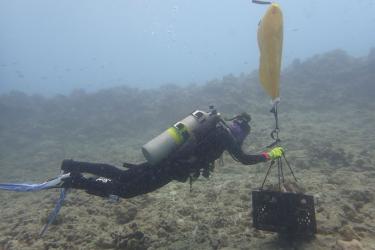A team of NOAA researchers and collaborators recently shed light on the small population of endangered hawksbill sea turtles in Hawaiʻi. Their study revealed that most Hawaiian hawksbills spend their entire lives within the archipelago, making them true Hawaiʻi locals. The study also revealed that long ago, Hawaiʻi likely served as a “stepping stone” for hawksbills to colonize other parts of the Pacific Ocean.
Hawksbills in Hawaiʻi
Most baby sea turtles emerge from their nests and travel long distances across the open ocean to settle in nearshore feeding habitats as young juveniles. There, they continue to feed and grow. Turtles from many different parts of the world can dwell in a single feeding habitat. But when they reach sexual maturity, the females return to the nesting beach where they hatched to lay nests of their own. After several generations of the same migration pattern, a nesting population can become genetically unique.
The endangered hawksbill sea turtle, or “Honuʻea” in Hawaiian, lives and feeds in the nearshore waters around the Hawaiian Archipelago. They particularly like areas of healthy coral reefs, where their narrow beaks enable them to access sponges—one of their favorite food items. Hawksbills are very rare in Hawaiʻi compared to the green sea turtle (or “Honu” in Hawaiian), which outnumber hawksbills by about 100 to one. Needless to say, seeing a hawksbill turtle is as much a privilege as it is a wonder. We see fewer than 15 females nesting annually across the entire archipelago. In fact, this may be one of the smallest nesting sea turtle populations in the world.
The Hawaiian hawksbill nesting population is, however, the largest in the U.S. Pacific Ocean and the only known nesting colony in the Central North Pacific. Hawaiian hawksbills face several threats:
- Non-native mongoose, feral cat, and rat predation on eggs and destruction of nests.
- Fishing gear entanglement in nearshore feeding habitats.
- Development and climate change alteration of nesting and feeding habitats.
Genetic Characterization of Hawksbills in Hawaiʻi
For the first time, NOAA scientists and collaborators published a genetic study of hawksbill turtles around Hawaiʻi. The study first compared the hawksbill nesting colony in Hawaiʻi with several nesting colonies in the western and eastern Pacific. Genetic results indicated that the Hawaiian hawksbill nesting population is different from hawksbill nesting populations in other parts of the world.
The scientists then examined whether hawksbills in feeding habitats around the Hawaiian Islands came from different nesting beaches across the Pacific. They found that the overwhelming majority of hawksbills in Hawaiian waters originated from nesting beaches around Hawaiʻi. These findings suggest that most hawksbills in Hawaiʻi spend their entire lives around the archipelago, making them true Hawaiʻi locals.
This can be good news for wildlife managers because conserving species that migrate across international borders can be complicated. However, being strictly local to Hawaiʻi, hawksbills may be particularly vulnerable to local threats. It is important to protect the species throughout the archipelago and learn more about their conservation needs.
Hawaiian Hawksbills Across the Pacific
It appears Hawaiian hawksbills are largely a closed population. However, some of the turtles from the Hawaiian nesting colony may migrate to other feeding habitats in the western Pacific. Hawaiʻi may have also acted as a “stepping stone” during the evolution of Hawksbill nesting populations across the Pacific. Hawksbills likely migrated out of the western Pacific to establish a nesting colony on Hawaiʻi. Later generations likely ventured out of Hawaiʻi to establish nesting colonies in the eastern Pacific.
There is still a lot to learn about Hawaiian hawksbills. Although we have identified several important nesting and feeding areas around the archipelago, evidence suggests that additional nesting and foraging areas have yet to be discovered. We want to know where these areas are located, how many hawksbill sea turtles use them, and what threats may exist. These crucial questions all need to be answered to ensure survival of the Hawaiian hawksbill population.
NOAA will continue to work with local partners and communities to answer these questions and ensure these local Hawaiʻi hawksbills remain part of our collective community for future generations.
For additional information on this story, contact Dr. Alexander Gaos. All photos taken under permit.





